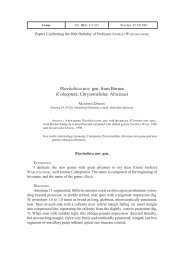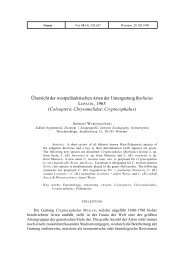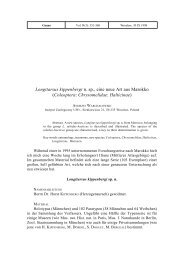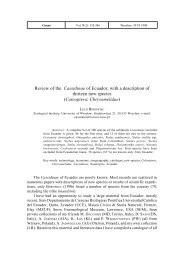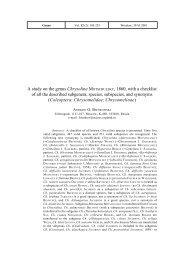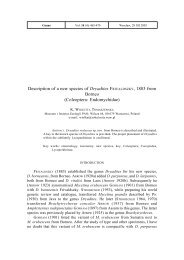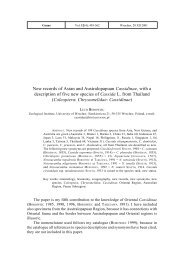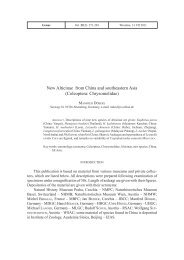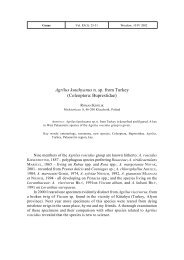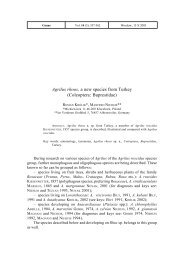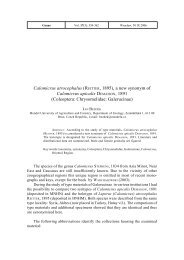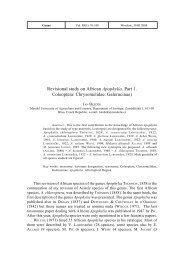Studies on asiatic Apophylia. Part 5: Revisional study of type ...
Studies on asiatic Apophylia. Part 5: Revisional study of type ...
Studies on asiatic Apophylia. Part 5: Revisional study of type ...
You also want an ePaper? Increase the reach of your titles
YUMPU automatically turns print PDFs into web optimized ePapers that Google loves.
488 JAN BEZDÌK<br />
Macropterous.<br />
Ventral surface lustrous, finely punctured and covered by pale hairs.<br />
Basimetatarsomere 1.25 times as l<strong>on</strong>g as two following metatarsomeres combined.<br />
Body length 4.65-5.95 mm.<br />
The shape <strong>of</strong> aedeagus as in Fig. 8.<br />
Sexual dimorphism: Male: Last visible sternite with very large semicircular<br />
incisi<strong>on</strong>. Claws bifid. Antennomere 8 largely extended. Female: Last visible<br />
sternite complete. Claws appendiculate. Antennomere 8 <strong>on</strong>ly slightly extended.<br />
Distributi<strong>on</strong>. China (Tibet).<br />
<strong>Apophylia</strong> maculicollis (JACOBY, 1895)<br />
Malaxia maculicollis JACOBY, 1895: Stett. Ent. Z., 56: 71 (<strong>type</strong> locality: New. Guinea).<br />
<strong>Apophylia</strong> maculicollis: WEISE, 1924: 183; WILCOX, 1971: 145.<br />
TYPE MATERIAL EXAMINED<br />
Lecto<strong>type</strong> (male), present designati<strong>on</strong>, labelled: „N. Guinea [w, h] // 2ndJacoby<br />
Coll. [w, p] // maculicollis Jac. [w, h] // Type [p] 18494 [red label, h] // Malaxia<br />
maculicollis Jacoby TYPE [w, h]“ (in MCZC). The lecto<strong>type</strong> is provided with <strong>on</strong>e<br />
red label: „LECTOTYPUS Malaxia maculicollis Jacoby, 1895, des. J. Bezdìk<br />
2003”.<br />
Aedeagus as in Fig. 11.<br />
Distributi<strong>on</strong>. New Guinea.<br />
COMMENTS<br />
JACOBY (1896) evidently described A. maculicollis from several specimens,<br />
because he menti<strong>on</strong>ed the variati<strong>on</strong> length <strong>of</strong> the body size in his descripti<strong>on</strong>.<br />
However, I had the possibilty to <strong>study</strong> <strong>on</strong>e male deposited in MCZC and designated<br />
it as the lecto<strong>type</strong>.<br />
JACOBY obviously overlooked male metasternum modified to small protuberance<br />
directed downwards (Fig. 9). Due to this character, A. maculicollis seems to<br />
be very near to A. basilana PIC, 1945. Both species differ in colorati<strong>on</strong> <strong>of</strong><br />
pr<strong>on</strong>otum (yellow with central black spot in A. maculicollis, yellow or yellow with<br />
indistinct dark spot in A. basilana), in the structure <strong>of</strong> male metasternal protuberance<br />
(Figs 9-10) and in the structure <strong>of</strong> aedeagus (Figs 11-12).<br />
ALLARD (1889) described <strong>Apophylia</strong> maculicollis from South Africa. Later,<br />
JACOBY (1903) transferred this species into the genus Palaeoapophylia JACOBY,<br />
1903. In view <strong>of</strong> this fact, Allard´s maculicollis and JACOBY´s maculicollis are not<br />
c<strong>on</strong>generic. According to Internati<strong>on</strong>al Code <strong>of</strong> Zoological Nomenclature (59.2.),<br />
new name for JACOBY´s maculicollis is not necessary.



